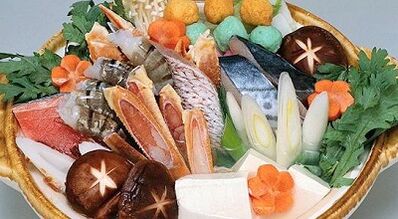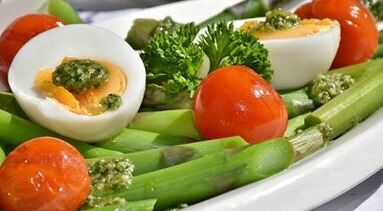
The fact that people do not suffer from obesity in Japan is associated with a special way, on the basis of which nutritionists constituted a menu called "Japanese diet".
It is based on the use of low calorie products: fat and carbohydrates.According to the Japanese method, the diet is considered one of the most effective, its effectiveness is a loss of up to 8 kg in only two weeks.
The most effective Japanese diet for weight loss
An effective diet was developed by the Dietetic doctors of the Japanese Yaex clinic.With rigorous observance for two weeks, the metabolism in the body is completely renovated, which remains for at least two years.
The Japanese diet for weight loss is not completely able to use traditional Japanese food, includes products such as:
- fish;
- meat;
- vegetables;
- egg;
- fruit;
- cracker.
Japanese diet Yelo
This Japanese diet is designed by the dieticians of the Japanese Clinic Yeelo, therefore it has obtained the name.For those who practice such nutrition, sugar, bakery and any product for flour and alcohol are severely prohibited.It is necessary to drink a lot of simple or mineral clean water in the breaks between meals, the salt is also undesirable, because it delayed water in the body.
1 day
- In the morning a glass of sugar -free coffee is allowed;
- Lunch includes a boiled cabbage salad with butter, a glass of tomato juice and two boiled eggs without salt;
- Dinner consists of fried fish no more than 200 grams.
2 days
- In the morning, traditional coffee with a small cragker;
- Lunch includes various fish options and a fresh cabbage salad with a small amount of oil;
- For dinner - Boiled meat in a quantity of 200 grams and a glass of kefir.

3 days
- Coffee already familiar with the cragkers;
- The lunch consists of stewed vegetables - 1st courgettes or eggplant in oil;
- For dinner, you can enjoy 200 g of cooked beef, two steep eggs and a cabbage salad sprinkled with oil.
4 days
- The breakfast is made up of a cup of black coffee;
- Lunch includes 3 large boiled carrots, a raw egg (wash it only with great attention) and 15 g of cottage cheese or non -salted cheese;
- For dinner, a little fruit is not allowed more than 240 g.
5 days
- For breakfast, we go without coffee, replacing it with a salad of raw carrot, clumsy with lemon juice;
- For lunch it allows you to enjoy large fish in any shape and a glass of tomato juice;
- For dinner, a little sweet fruit, no more than 240 g.
6 days
- The breakfast is made up of coffee;
- For lunch, you can eat 500 g of boiled chicken and a cabbage and carrot salad, injected oil;
- The dinner consists of 2 hard -boiled eggs and carrot salad with butter.
7 days
- For breakfast you can drink sugar -free tea;
- Lunch consists of 200 g of boiled beef;
- Dinner can be one of those proposed previously, with the exception of the third day dinner.
- 8-14 days, you have to repeat the sixth day at the first.
Japanese sleepless diet
This Japanese diet for 7 days repeats completely the week of the above diet, its feature is the complete absence of salt.The diet in a week normalizes the metabolism and will allow the development of adequate eating habits.
The lack of salt in the diet for a week brings many benefits to the body:
- It helps to get rid of excess weight.
- Rejuvenates the body.
- Toxins controversies.
- Eliminates the internal edema.
But it should be understood that sleepless nutrition is strictly contraindicated:
- pregnant and stirring;
- Those who have hard physical work;
- Those who have sick liver, kidneys and heart.
Japanese protein diet

For those who have been overweight for many years, a diet similar to proteins and salt can become a real salvation.
Unlike analogues, such a diet per day is at least 200 g of vegetables and 250-450 g of protein in complete absence of sugar and other carbohydrates.Therefore, those who want to lose weight: the Japanese diet can help a lot.
Japanese water diet
Almost all the Japanese know this miraculous diet:
- Every day, on an empty stomach before washing your teeth, you have to drink 3 cups of hot water (necessarily hot, this is very important).
- Within 45 minutes there is nothing or drink.
- As always, to have breakfast.
- The next meal is not before 2 hours.
The Japanese water diet helps to recover from such serious diseases:
- constipation - 10 days;
- Gastritite - 10 days;
- Hypertension - term 1 month;
- Stomach ulcer - 1 month;
- Diabetes - 1 month;
- Tuberculosis - 3 months;
- Psoriasis - 6 months;
- Cancer - 6 months.
But to always be healthy, many Japanese have started the day with hot water for years.It is not forbidden to add a little citric acid for water taste.In many people, the simultaneous intake of three glasses can cause difficulty, so doctors recommend starting with a glass and gradually increase the amount of drunk water.
Japanese banana diet
This is probably the simplest and tastiest way of weight loss.All you have to do is replace the traditional breakfast with different bananas.A severe Japanese diet involves the exclusion of dairy products -caseari, sweets and fat from the diet.Coffee and tea are not welcome, the only drink allowed is water.How does such a diet work?Bananas improve the metabolism, the starch the bananas saturate the body and do not want to eat for a long time.
Japanese rice diet

This diet is another effective way to lose weight.The entire essence of the diet is that in the morning he begins with the reception of a dried half, soaked at least 5 days of rice.After such a "breakfast" it is forbidden to eat at least 3 hours.This real Japanese diet helps to lose at least 5 kilograms in two weeks.
What to do:
- Take 5 glasses with water, put 2 tablespoons of steam rice there not to steam (those who weigh more than 65 kg need 3 tablespoons).
- Every day you have to change water in the glasses.
- As soon as 5 days pass, you have to take the rice from the first glass and eat it instead of breakfast.
- In the released glass, it is necessary to add 2 tablespoons of rice and put it last.
- So, get 5 glasses with rice, which have been immersed in water for 5 days.The rice soaked in water is a "brush" that collects and removes all toxins from the body.Internal edema and excess salt will leave your body forever.
Japanese tea diet
This new Japanese diet involves the use of a large amount of green Japanese tea, as well as:
- 200 g per day of meat or fish;
- stewed or fresh vegetables;
- cooked on tea in small quantities;
- no more than 150 g of ricotta a day;
- no more than 2 eggs for dinner;
- Dinner consisting of 250 g of fruit.
The meaning of this diet is that at least 1.5 liters of green tea stimulates digestion, removes toxins and excess liquid from the body.During the purification path, it is forbidden to drink something different from tea and pure water.The restriction is also applied to sweet products, flour, pastries, salt.For those who can resist at least two weeks of this diet, nutritionists promise a loss of at least 3 kg per week.
How to get out of the Japanese diet?
No matter how many days you have joined a Japanese diet - a week or two, above all, to leave it correctly.The exit from the Japanese diet provides for further exclusion from the diet of dessert and flour.It is equally important not to eat in the evening before bedtime.This mode will allow you to correct the excellent result of the diet for many years.
If you suffer from extra kilos, such a diet will help to move the case of weight loss from the deadline.How does the Japanese diet work?Since its diet is made up of proteins, whose processing requires more energy that enters the body, we begin to spend more calories than to receive.The lack of salt does not allow water to accumulate in the fabrics and removes the hidden edema.For this reason, get rid of an extra 5-8 kilograms.























